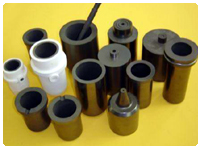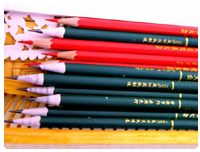| Property and application
Graphite is carbon crystal and nonmetal material with the natures
of silver gray, soft texture, metal luster, Mohs hardness 1~2, specific
gravity 2.2~2.3 and volumetric weight 1.5~1.8 in general.
Graphite features very high melting point. It starts to melt at
3000°C in vacuum and evaporates at 3600°C. Strength of most materials
decreases under high temperature but, on the contrary, the strength
of graphite will increase in double when it is heated to 2000°C.
However, graphite’s oxidation resistance property is poor and temperature
rise may quicken the Oxidation process of graphite.
 Graphite
is noted for excellent thermal and electrical conductivity, which
is 4 times that of stainless steel, 2 times that of carbon steel
and 100 times that of most nonmetal materials. Of graphite, thermal
conductivity is better than that of metals, including steel, iron
and lead, but decreases when temperature rises. Unlike metals, when
temperature is extremely high, graphite will be of thermal insulation.
So, the property of graphite in heat insulation under high temperature
is accountable. Graphite
is noted for excellent thermal and electrical conductivity, which
is 4 times that of stainless steel, 2 times that of carbon steel
and 100 times that of most nonmetal materials. Of graphite, thermal
conductivity is better than that of metals, including steel, iron
and lead, but decreases when temperature rises. Unlike metals, when
temperature is extremely high, graphite will be of thermal insulation.
So, the property of graphite in heat insulation under high temperature
is accountable.
Graphite features excellent lubrication and plasticity. Friction
coefficient of graphite is less than 0.1. Graphite can be extended
into poromeric and transparent thin flakes. Due to high strength,
graphite is unlikely processed even with a diamond cutter.
Graphite has stable chemical properties and resists corrosions
of acid, alkali and organic solvent. Currently, graphite has been
widely used in modern industries.
1. Fireproof material: graphite and graphite products have the properties
of high temperature resistance and high strength and are used for
production of graphite crucible, protection of iron ingot and inner
lining in metallic furnace.
 2.
Electric conducting material: in electrical industry, graphite is
used for production of electrode, brush, carbon rod, carbon tube,
positive pole of mercury rectifier, washer, telephone component
and coating of television tube. 2.
Electric conducting material: in electrical industry, graphite is
used for production of electrode, brush, carbon rod, carbon tube,
positive pole of mercury rectifier, washer, telephone component
and coating of television tube.
3. Antifriction material: graphite is often used as lubricant in
machinery production. Common lubricating oil cannot be used under
high rotation speed, high temperature and high pressure. The equipment
made of graphite antifriction materials can be operated at high
rotation speed under 200~2000°C without any lubricating oil. Graphite
is also used in piston ring, sealing ring and bearing of the equipment
of corrosive medium delivery and does not require any lubricant.
Graphite emulsion can be used as lubricant in metal wire and tube
drawing.
4. Graphite with stable chemical property: specially treated graphite
features excellent corrosion resistance and thermal conductivity
and low penetration rate and, as a result, can be used in heat exchanger,
reaction tank, condensator, combustion tower, absorbing tower, cooling
and heating systems, as well as filter and pump in industries of
petrochemical, hydrometallurgy, acid/alkali, synthetic fiber and
paper making as a substitution of metal materials.
5. Used in foundry, molding, pressing die and high temp metallurgy:
due to minor coefficient of thermal dilation and property of thermal
shock resistance, graphite is used in glass ware molding to ensure
precise dimensions of cast ferrous metal and excellent surface smoothness,
resulting in significant reduction of metal consumption. In production
of metal powder, such as hard metal alloy, graphite is used in pressing
die and sintering crucible. Highly purified graphite is used in
single crystal silicon growth crucible, regional refinery vessel,
support clamp and induction heating apparatus. In addition, graphite
can also used in heat insulation, base support, high temperature
furnace tube, rod, panel and grate in process of vacuum metallurgy.
 6.
Used in A-energy and national defense industry: as a neutron moderator,
graphite is used in atomic reactor, ie. uranium-graphite reactor,
the most popular one in the world at present. Graphite meets the
requirements of atomic reactor due to its properties of high melting
point, stability and corrosion resistance when used as a moderator.
When used in atomic reactor, impurity in graphite must not be in
excess of some dozens of PPM. Especially the content of boron should
be less than 0.5PPM. In national defense industry, graphite is used
for production of nozzles of solid fuel for rockets, nose cone of
missiles, and parts, insulation and ray-proof components of spacecrafts. 6.
Used in A-energy and national defense industry: as a neutron moderator,
graphite is used in atomic reactor, ie. uranium-graphite reactor,
the most popular one in the world at present. Graphite meets the
requirements of atomic reactor due to its properties of high melting
point, stability and corrosion resistance when used as a moderator.
When used in atomic reactor, impurity in graphite must not be in
excess of some dozens of PPM. Especially the content of boron should
be less than 0.5PPM. In national defense industry, graphite is used
for production of nozzles of solid fuel for rockets, nose cone of
missiles, and parts, insulation and ray-proof components of spacecrafts.
7. Graphite has the function to prevent scale from buildup in boilers.
Experiment result shows that scale does not form on boiler surfaces
if a certain quantity of graphite is added into water, usually 4~5g
per ton. In addition, graphite can prevent rusts on metal chimney,
building roof, bridge and pipeline.
8. Graphite can be used as pencil core, pigment and polishing agent.
After special treatment, graphite is used in some industries as
impervious graphite, highly oriented graphite and graphite fabrics.
|



